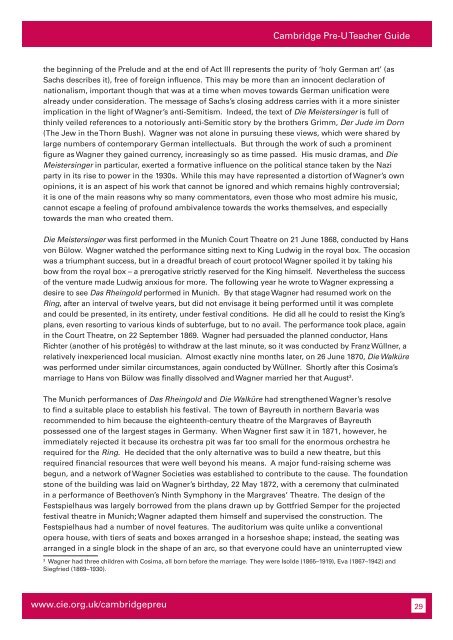Teacher's Guide Cambridge Pre-U MUSIC Available for teaching ...
Teacher's Guide Cambridge Pre-U MUSIC Available for teaching ...
Teacher's Guide Cambridge Pre-U MUSIC Available for teaching ...
Create successful ePaper yourself
Turn your PDF publications into a flip-book with our unique Google optimized e-Paper software.
<strong>Cambridge</strong> <strong>Pre</strong>-U Teacher <strong>Guide</strong><br />
the beginning of the <strong>Pre</strong>lude and at the end of Act III represents the purity of ‘holy German art’ (as<br />
Sachs describes it), free of <strong>for</strong>eign influence. This may be more than an innocent declaration of<br />
nationalism, important though that was at a time when moves towards German unification were<br />
already under consideration. The message of Sachs’s closing address carries with it a more sinister<br />
implication in the light of Wagner’s anti-Semitism. Indeed, the text of Die Meistersinger is full of<br />
thinly veiled references to a notoriously anti-Semitic story by the brothers Grimm, Der Jude im Dorn<br />
(The Jew in the Thorn Bush). Wagner was not alone in pursuing these views, which were shared by<br />
large numbers of contemporary German intellectuals. But through the work of such a prominent<br />
figure as Wagner they gained currency, increasingly so as time passed. His music dramas, and Die<br />
Meistersinger in particular, exerted a <strong>for</strong>mative influence on the political stance taken by the Nazi<br />
party in its rise to power in the 1930s. While this may have represented a distortion of Wagner’s own<br />
opinions, it is an aspect of his work that cannot be ignored and which remains highly controversial;<br />
it is one of the main reasons why so many commentators, even those who most admire his music,<br />
cannot escape a feeling of profound ambivalence towards the works themselves, and especially<br />
towards the man who created them.<br />
Die Meistersinger was first per<strong>for</strong>med in the Munich Court Theatre on 21 June 1868, conducted by Hans<br />
von Bülow. Wagner watched the per<strong>for</strong>mance sitting next to King Ludwig in the royal box. The occasion<br />
was a triumphant success, but in a dreadful breach of court protocol Wagner spoiled it by taking his<br />
bow from the royal box – a prerogative strictly reserved <strong>for</strong> the King himself. Nevertheless the success<br />
of the venture made Ludwig anxious <strong>for</strong> more. The following year he wrote to Wagner expressing a<br />
desire to see Das Rheingold per<strong>for</strong>med in Munich. By that stage Wagner had resumed work on the<br />
Ring, after an interval of twelve years, but did not envisage it being per<strong>for</strong>med until it was complete<br />
and could be presented, in its entirety, under festival conditions. He did all he could to resist the King’s<br />
plans, even resorting to various kinds of subterfuge, but to no avail. The per<strong>for</strong>mance took place, again<br />
in the Court Theatre, on 22 September 1869. Wagner had persuaded the planned conductor, Hans<br />
Richter (another of his protégés) to withdraw at the last minute, so it was conducted by Franz Wüllner, a<br />
relatively inexperienced local musician. Almost exactly nine months later, on 26 June 1870, Die Walküre<br />
was per<strong>for</strong>med under similar circumstances, again conducted by Wüllner. Shortly after this Cosima’s<br />
marriage to Hans von Bülow was finally dissolved and Wagner married her that August 3 .<br />
The Munich per<strong>for</strong>mances of Das Rheingold and Die Walküre had strengthened Wagner’s resolve<br />
to find a suitable place to establish his festival. The town of Bayreuth in northern Bavaria was<br />
recommended to him because the eighteenth-century theatre of the Margraves of Bayreuth<br />
possessed one of the largest stages in Germany. When Wagner first saw it in 1871, however, he<br />
immediately rejected it because its orchestra pit was far too small <strong>for</strong> the enormous orchestra he<br />
required <strong>for</strong> the Ring. He decided that the only alternative was to build a new theatre, but this<br />
required financial resources that were well beyond his means. A major fund-raising scheme was<br />
begun, and a network of Wagner Societies was established to contribute to the cause. The foundation<br />
stone of the building was laid on Wagner’s birthday, 22 May 1872, with a ceremony that culminated<br />
in a per<strong>for</strong>mance of Beethoven’s Ninth Symphony in the Margraves’ Theatre. The design of the<br />
Festspielhaus was largely borrowed from the plans drawn up by Gottfried Semper <strong>for</strong> the projected<br />
festival theatre in Munich; Wagner adapted them himself and supervised the construction. The<br />
Festspielhaus had a number of novel features. The auditorium was quite unlike a conventional<br />
opera house, with tiers of seats and boxes arranged in a horseshoe shape; instead, the seating was<br />
arranged in a single block in the shape of an arc, so that everyone could have an uninterrupted view<br />
3 Wagner had three children with Cosima, all born be<strong>for</strong>e the marriage. They were Isolde (1865–1919), Eva (1867–1942) and<br />
Siegfried (1869–1930).<br />
www.cie.org.uk/cambridgepreu 29
















